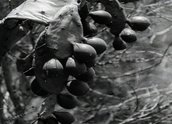
Australasian Gazette – Prickly Pear Infested Areas of Australia (1926)
Synopsis
This silent newsreel from approximately 1926 opens with a map which shows the prickly pear infested areas of northern New South Wales and Queensland. A map of England is then superimposed over the infested areas to illustrate the extent of the problem. Images of bushland in eastern Australia infested with the noxious prickly pear cactus are followed by the efforts of scientists trying to combat the problem. Cochineal insects are shown crawling over a piece of prickly pear and a Cactoblastis moth emerges from a chrysalis. The newsreel closes with cattle grazing in bushland free of the prickly pear.
Curator’s notes
Used originally for hedges and to mark paddock boundaries, the prickly pear spread easily, encouraged by a lack of predators and optimal climatic conditions. By 1925 the prickly pear infested over 25 million hectares in New South Wales and Queensland.
The exact origin of the prickly pear is unknown but one theory is that it was brought to Australia on the First Fleet. Some believe that Captain Arthur Phillip collected them in Brazil on his way to Botany Bay in the hope of developing a strong cochineal dye industry for Britain. Cochineal insects live on the prickly pear cactus and are squashed to produce dyes.
Cactoblastis caterpillar larvae were introduced to help control the spread of the prickly pear in 1926. Within 10 years the prickly pear were almost eradicated.
- Overview
- Curator’s notes
- Video full title

- Find a copy
- Make a comment
- Add your review



